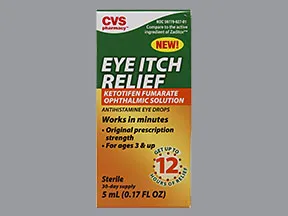

Some types of eye drops have a lid that pops on and off easily, which can lead to spills in your purse or backpack. If you’re using eye drops for moderate to severe allergies, consider choosing a formula with a term like “moisturizing,” “hydrating,” or “lubricating” in the description. Features MoisturizingĮye drops that combat itchiness and redness can sometimes dry out the eyes, especially with long-term or frequent use. These eye drops help prevent mast cells in the body from producing histamine. Mast cell eye drops are available OTC and by prescription and are especially helpful for contact lens wearers because they can be safely used long term. Mast cell eye drops: This newer type of eye drop can be a lifesaver for people with severe or long-lasting allergies. This type of eye drop is prescribed only for severe cases and is not ideal for long-term use unless absolutely necessary.

Steroidal eye drops: Corticosteroid eye drops are available by prescription only, since they have additional risks and side effects like vision problems and eye pressure.

These eye drops are available in OTC and prescription form. Anti-inflammatory eye drops usually cause a mild, brief stinging sensation. They take effect more slowly than antihistamine eye drops (usually around an hour) but may last significantly longer, from 6 to 12 hours. You’ll find both OTC and prescription options available.Īnti-inflammatory eye drops: These eye drops work by soothing the nerve endings in the eye itself. Antihistamine eye drops block histamine (a chemical your body produces in response to a perceived threat, like pollen or pet dander) to help calm redness, swelling, and itchiness.Īntihistamine eye drops work quickly, but their effectiveness often wears off within a few hours. Some can be purchased by prescription only but are formulated for daily treatment of more severe symptoms.Īntihistamine eye drops: Antihistamine eye drops are the first recommended line of defense for people with mild to moderate seasonal allergies. Many are OTC products intended to combat seasonal allergy symptoms. There are four types of eye drops you can use for allergy relief. Always follow the directions on the label regarding the number of times you can safely use the eye drops per day. If you find yourself reaching for OTC eye drops multiple times a day for an extended period of time, it’s a good idea to talk to your doctor about stronger prescription options or combining formulas. Look for phrases like “long-lasting” or “12-hour protection.” Those who use allergy eye drops for infrequent but acute flare-ups should choose a fast-acting formula that clearly addresses their worst symptoms. Frequency of useĭo you need eye drops for allergy relief once every few weeks when you go for a hike in the mountains? Every day during the summer? Those who frequently use allergy eye drops should choose a formula made for long-term use. Note that eye drops advertising “dual-acting” or “multi-symptom” treatment is usually more effective at tackling several symptoms.

Other formulas reduce redness but are less effective at relieving itching and swelling.Ĭhoose an eye drop formula that advertises specific claims about the ocular symptom, or symptoms, that bother you most. For example, some formulas are great at knocking out itching and wateriness but less effective at clearing up redness. Keep in mind that the majority of over-the-counter (OTC) eye drops for allergies are geared toward treating one or two symptoms. Your first considerations when choosing eye drops for allergies should be the severity of your allergy symptoms, how often you need to use eye drops, and the type of eye drops that best meet your needs. Wearing sunglasses can help protect your eyes from pollen and other outdoor allergens.


 0 kommentar(er)
0 kommentar(er)
